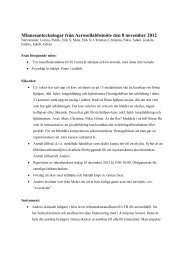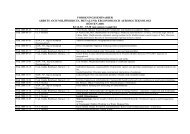ESTIMATING CLOUD DROPLET EFFECTIVE RADIUS ... - CAST
ESTIMATING CLOUD DROPLET EFFECTIVE RADIUS ... - CAST
ESTIMATING CLOUD DROPLET EFFECTIVE RADIUS ... - CAST
- No tags were found...
You also want an ePaper? Increase the reach of your titles
YUMPU automatically turns print PDFs into web optimized ePapers that Google loves.
<strong>ESTIMATING</strong> <strong>CLOUD</strong> <strong>DROPLET</strong> <strong>EFFECTIVE</strong> <strong>RADIUS</strong> FROM SATELLITE REFLECTANCE DATAModified Exponential Approximation___________________________________________________________________________________________________where F(θ) ≈ p(θ), and p(θ) is the phase function. The phase function of a cloudy medium ishere approximated using the Henyey-Greenstein function for g 1 , given by Eq. (2.5) where(Kokhanovsky et al., 2003; Kokhanovsky, 2004a).θ = arccos( −cosµ cos µ0+ sin µ sin µ0cosϕ)(2.41)Eq (2.30-2.41) generates the reflection function in the NIR and MIR wavelengths. For anaccuracy of R ∞ 0 (Eq. (2.40)) better than 7%, the observation angles must be smaller than 30°and incident angles lower than 70° (Kokhanovsky, 2004b). This is generally not a problemwith remote sensing images, but must be checked for when running the model, especially ifthe pixels are located far from the centre of the image. In the selected area of study the sensorzenith angles were all smaller than 17°, and the solar zenith angles were within the range 38°-41°.2.2 Data and ComputationsBy comparing the calculated reflection function with the measured value in the correspondingwavebands, the effective radius can be determined. For the retrieval of the effective radius incumulus cloud tops, reflectance data from at least two wavebands (visible and NIR/MIR) isrequired. The light intensity measured from space is however both reflected and emitted light.Satellite sensors cannot distinguish between reflected and emitted light, the photons areidentical if in the same wavelength, so how does one come around this problem?Emitted light is due to absorption by in this case water vapour present in the cloud andsurrounding atmosphere. The easiest way to discriminate reflected light from emitted light isprobably to use wavebands with minimal water vapour absorption. For the purpose ofdetermining the cloud droplet radius we are interested in comparing the reflected light in thevisible region with no absorption, with the reflected light in the near/mid infrared region,where cloud drops absorb some of the incident light, depending on the liquid water content. Inthe visible with almost no absorption there is no problem. But in the near and mid infrared(~ 0.7 – 1.3 and 1.3 – 3.0 µm respectively (Lillesand et al., 2004, Remote Sensing and ImageInterpretation, p. 6)) water vapour absorption occur at 0.72, 0.82, 0.94, 1.1, 1.38, 1.87, 2.7 and3.2 µm with the strongest peaks at 1.38, 1.87 and 2.7 µm (Liou 1992, p.157, Liou 2002, p. 83,371). Therefore one must choose wavebands in between these wavelength bands where theliquid water absorption is still sufficiently strong to show differences in reflection comparedto the visible (for the same reason the cloud optical thickness must not be too small). Suitablewavelengths for these requirements, often used in remote sensing analysis of clouds are 0.5 –0.7 µm in the visible and 1.6, 2.2 and 3.7 µm in the NIR and MIR (Platnick, 2000). Becausethese three wavelengths show different sensitivity to underlying surface reflection andatmospheric water vapour absorption one may wish to use more than one of thesewavelengths in order to reduce the uncertainty.Rosenfeld et al. (2004) studied NOAA and METOP satellite measurements of cloudmicrophysical properties and found that 1.6 and 3.7 are equally (un)suitable for deriving clouddroplet effective radius. The 3.7 µm waveband is more sensitive to cloud top reflectance.However, in this waveband solar reflection and thermal emission occur simultaneously, andso it is more sensitive to atmospheric water vapour. On the other hand, the 1.6 µm is moreaffected by underlying surface reflection, which is a relevant problem in smaller clouds.Another disadvantage with 1.6 µm waveband is that the radiation may originate from deepinside the cloud, and must therefore be corrected if cloud top radiation is wanted. This also16




